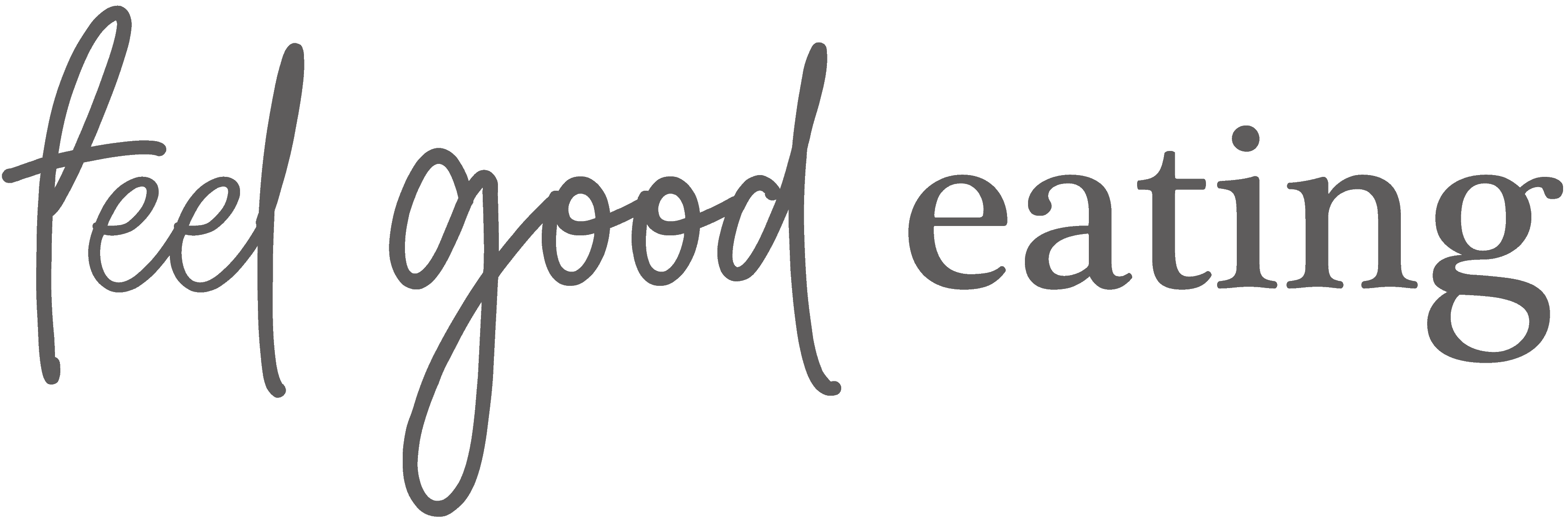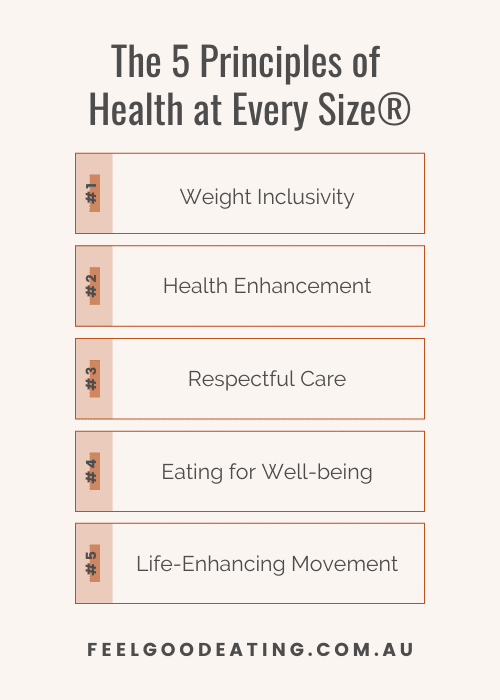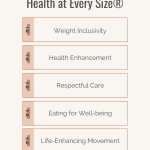HAES® stands for Health at Every Size and is a term trademarked by the Association of Size Diversity and Health (ASDAH) as well as HAES Australia.
At its core, HAES champions the right to pursue health and wellbeing in personally meaningful ways, no matter one’s size. It provides a framework for taking care of ourselves that does not hinge on the pursuit of weight loss or weight maintenance.
HAES acknowledges that ‘health’ is experienced differently by everyone and that what influences health is much more complex than body size, what and how much we eat and how much we exercise.
By extension, HAES is also a framework that healthcare providers work within, that allows them to support the wellbeing of all bodies without defaulting to prescribing weight loss or upholding stigmatising attitudes and beliefs about fat bodies.
HAES is not just a framework for application at the individual level. The HAES ethos and framework is actually more powerful when integrated and applied at a system level. Whether that be your local medical clinic, in hospitals, within curriculums training healthcare professionals, in government policy and public health initiatives.
The Five Principles of HAES
There are five principles of HAES as defined by the Association for Size Diversity and Health and endorsed by HAES Australia. They were originally developed in 2003, but the origins of HAES stretch back earlier than that – way back to the 1960s and the emerging fat activist movements (you can read more about the history of HAES here).
The principles were revised in 2013 to be more inclusive, intersectional and clear about ASDAH’s stance on other forms of discrimination.
The five principles are:
- Weight Inclusivity: Accept and respect the inherent diversity of body shapes and sizes and reject the idealizing or pathologizing of specific weights.
- Health Enhancement: Support health policies that improve and equalize access to information and services, and personal practices that improve human well-being, including attention to individual physical, economic, social, spiritual, emotional, and other needs.
- Respectful Care: Acknowledge our biases, and work to end weight discrimination, weight stigma, and weight bias. Provide information and services from an understanding that socio-economic status, race, gender, sexual orientation, age, and other identities impact weight stigma and support environments that address these inequities.
- Eating for Well-being: Promote flexible, individualized eating based on hunger, satiety, nutritional needs, and pleasure, rather than any externally regulated eating plan focused on weight control.
- Life-Enhancing Movement: Support physical activities that allow people of all sizes, abilities, and interests to engage in enjoyable movement, to the degree that they choose.
HealthY at Every Size: Myths and Misconceptions about HAES
Given HAES is counter-cultural, it is not surprising that there are a number of myths and misconceptions about it, the most common one being that HAES stands for HealthY at Every Size and therefore presumes that everyone is healthy, regardless of their size.
It is just one letter, but the addition of the Y to the end of ‘health’ does change the whole meaning of HAES. (FYI This was why HAES was trademarked, in order to protect the true meaning and intentions of the framework.)
HAES does not deny that weight can be part of a person’s experience of health and wellbeing. For example, a person in a larger body being denied treatment or surgery until they lose weight, or a person with anorexia nervosa being critically unwell, in part, due to changes in their weight.
But what HAES is truly about, is a person’s right to pursue health and wellbeing in ways that are meaningful to them, rather than weight, shape or size being a guarantee and the ONLY indicator of their health status.
HAES promotes ‘unhealthy’ bodies
Nope. HAES acknowledges and embraces the natural diversity that has always existed in bodies and upholds the belief that ALL bodies, regardless of size, deserve respect and affirming healthcare.
If it seems that HAES elevates and amplifies the bodies, voices and needs of people who have been marginalised and discriminated against, then this can only be a good thing as we all need our biases to be challenged in order to change our culture.
HAES is only for people who have an eating disorder
While more healthcare providers working in the eating disorders space are embracing HAES as a practice model, that does not mean the principles of HAES are only for people with an eating disorder.
When we look specifically at Principles 1, 2 and 3 (weight inclusivity, health enhancement, respectful care), it is evident that Health at Every Size has the potential to transform public and private health systems for the benefit of all humans.
HAES is ‘anti- science’
Another common belief is that HAES is just a set of opinions, rather than being backed by science.
You are probably not going to find a lot of research looking at whether a HAES approach is effective for weight loss, because this goes totally against the point of HAES!
What you will find, is evidence supporting Health at Every Size as an approach when exploring the impacts of weight bias, weight stigma, weight cycling along with how engaging in a HAES approach can be beneficial for other markers of ‘health’.
HAES also seeks to expand what we consider ‘evidence’ and encompasses not only scientific evidence in the literature but also practice-based evidence, that is, the evidence, competence and experience that HAES providers gather while working with their clients and patients, along with what is probably most important: our own lived experience which will shape how we want to engage with health and what we will and won’t consent to.
Not to mention that HAES also has the complete body of weight loss research over the past 50 years to support its position that the intentional pursuit of weight loss as the panacea to health is futile and short-sighted.
You are not allowed to talk about weight or desire weight loss
We live in diet culture where weight bias and weight stigma are prevalent. It is impossible to not internalise messages about weight, bodies and health and have this shape our own relationship with food, body, health and weight.
When we know that the world treats smaller bodies better than it does larger bodies, it is completely understandable to want to divest from dieting AND still desire weight loss in order to conform to the social norm.
Therefore, conversations and stories about weight are an incredibly important part of the healing process. If you are working with a HAES provider, they will welcome these conversations.
What about weight and health?
The coupling of weight and health can be one of the trickiest mindsets to shift when understanding Health at Every Size.
I don’t think there is a HAES practitioner who will deny associations between weight and how people experience health and wellbeing (see the two examples I gave earlier).
While there may be associations between weight and health, what has overwhelming evidence – from a scientific literature, lived experience and practice-based evidence perspective; is that we do not have ways to safely help people lose weight long term. Where ‘safely’ MUST take into account a person’s physical, mental, emotional, financial, social, spiritual health.
A focus on weight as the ultimate ‘fix’ for health, is narrow-sighted and asks people to engage in often harmful behaviours that may or may not have the desired outcome of weight loss. And in doing so, it distracts or takes away from the ACTUAL ‘problem’ at hand.
For example, when we prescribe weight loss for a sore knee, it ignores the fact that the knee is sore now and/or has an injury and/or the knee and surrounding muscles and ligaments may be deconditioned due to the pain and reduced mobility. It asks the person to put their ‘hope’ in their knee pain resolving somewhere out into the future IF they achieve their weight loss goal.
HAES recognises those things (plus many others) can be contributing to the sore knee and seeks to assist the person to work on resolving their knee pain and the underlying cause NOW – if that is something they want to do.
If weight changes as a result of the behaviours the person engages in to heal and strengthen their knee, so be it.
Where to find a HAES provider
If considering your health and wellbeing from a HAES perspective sounds appealing and you would like to work with a health care provider that works within the HAES framework you can check out the provider listings at:




 Hi! My name is Nina.
I’m a Certified Intuitive Eating Counsellor taking the ‘diet’ out of Dietitian. I am here to help you reject diet culture, tune into your body’s own inner wisdom about how to truly nourish yourself and ultimately feel good eating™
Hi! My name is Nina.
I’m a Certified Intuitive Eating Counsellor taking the ‘diet’ out of Dietitian. I am here to help you reject diet culture, tune into your body’s own inner wisdom about how to truly nourish yourself and ultimately feel good eating™ 

